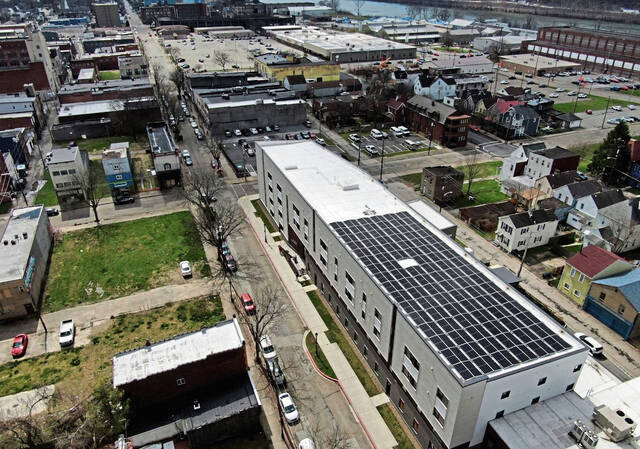Solar power for New Kensington, Harrison area buildings could save nearly $45 million over 25 years
Owners of 54 buildings in the New Kensington and Harrison areas could save nearly $45 million on their electric bills over the next 25 years if they unlocked the solar power potential of their properties, according to a Pittsburgh nonprofit.
“Nonprofits (would be) able to direct more funding toward their mission rather than operating expenses. Schools would be better able to invest in staff and resources for students, and businesses would have greater overhead to reinvest in materials and personnel,” said Amelia Eggan, program manager of the nonprofit Pennsylvania Solar Center.
A survey of New Kensington’s city hall and police department estimated it would cost about $31,270 to install solar panels there, after tax incentives. The panels would result in energy savings of $33,160 in the first year and $837,900 over 25 years, the Solar Center estimated.
The Solar Center plans to reach out in the next few months to owners of the properties it included in its solar mapping project, Eggan said. The timing depends on the center’s hiring of more employees, she said.
The nonprofit has a solar array atop the Pioneer Apartments building in downtown New Kensington, owned by Wesley Family Services. The nonprofit West Penn Power Sustainable Energy Fund gave Wesley Family Services a $170,700 grant to put toward the system, which cost about $209,000.
The 104.5-kilowatt solar energy system, installed by local developer EIS Solar, is expected to produce about 110,800 kilowatt hours and reduce the facility’s utility bill by 78%. EIS estimates the system will save Wesley about $700,000 over 25 years, or $28,000 a year over that time.
Assisted by the Solar Center team, volunteers conducted the virtual mapping project of buildings in New Kensington and Harrison last month. Twelve of the buildings were considered resilient and critical infrastructure sites, including schools, fire halls and police stations — areas where the community could gather in the event of an emergency, Eggan said.
The U.S. Energy Department has designated Westmoreland County as an “energy community,” meaning all entities in the commercial sector are eligible for a 40% reduction in the cost of a solar power project in the form of tax credits and direct-pay options, Eggan said. The 2022 Inflation Reduction Act provided for clean energy tax incentives that expanded current tax incentives and created new ones.
Further, New Kensington is designated as a Justice40 community, which the government defines as a disadvantaged community that has been marginalized by underinvestment and overburdened by pollution. Such communities can realize even greater savings, Eggan said.
In Westmoreland County, the Greensburg and Jeannette areas also are considered Justice40 communities, along with New Kensington, Arnold, West Newton, Monessen and part of Lower Burrell, according to a Justice40 tracts map. In the Alle-Kiski Valley, the Brackenridge, Ford City and Leechburg areas are identified as Justice40 communities.
“With these federal incentives, along with state benefits and grant opportunities, it is a historically opportune time for our region to adopt solar,” Eggan said.
Joe Napsha is a TribLive reporter covering Irwin, North Huntingdon and the Norwin School District. He also writes about business issues. He grew up on Neville Island and has worked at the Trib since the early 1980s. He can be reached at jnapsha@triblive.com.
Remove the ads from your TribLIVE reading experience but still support the journalists who create the content with TribLIVE Ad-Free.






